电子商务环境下的客户关系管理.doc
- 格式:doc
- 大小:33.50 KB
- 文档页数:7
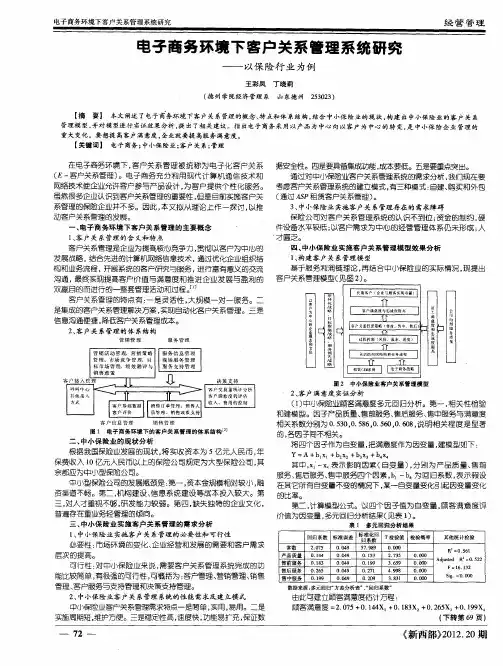

客户关系管理在电商平台中的应用在今天这个电商飞速发展的时代,客户关系管理越来越重要。
客户关系管理可以简单理解为企业与客户之间沟通、互动和互信的过程。
一个成功的电商平台不仅需要有高质量的产品和优秀的服务,更需要有一个完善的客户关系管理系统,以提高客户体验和忠诚度,从而促进销售增长。
客户关系管理的重要性首先,客户关系管理可以帮助电商平台了解和满足客户需求。
通过与销售客户交流、记录客户反馈,企业可以更好地理解客户的需求,这非常有利于定制化方案,提高客户满意度。
其次,客户关系管理可以增强客户忠诚度。
最好的客户是回头客,他们不仅购买产品,而且也为企业宣传、推广。
最后,客户关系管理可以提高企业的销售量。
对于电商平台,客户关系管理影响更是直接,因为客户是平台里的实际消费者,如考虑到客户的需求,客户的满意度,以及客户忠诚度,会让销售数量增长上升。
客户关系管理的实现客户关系管理的实现可以包括以下几个方面:第一,个性化的客户服务。
现代消费者非常关注个性化和定制化的服务,因此,客户关系管理需要根据客户的不同需求量身定制服务,以提高客户体验。
第二,多渠道的客户沟通。
不同的客户有不同的喜好,因此,企业需要在多个平台上实现多元化的客户沟通方式,比如邮件、手机短信、微信和电话等。
第三,系统化的跟进和回馈。
企业需要利用技术手段和数据管理工具实现与客户的跟进和反馈,记录客户真实的反馈结果,并根据反馈结果制定以改进服务计划。
第四,多元化的激励机制。
为了增强客户的忠诚度和消费意愿,客户关系管理需要设置个性化的激励机制,比如优惠券、积分、礼品等。
客户关系管理在电商平台中的应用客户关系管理在电商平台中的应用可以通过以下几个方面实现:第一,增加客户的购买体验。
优秀的客户关系管理可以帮助消费者获得良好的购买体验,通过提供个性化的服务以及回应客户的问题,客户可以满足自己的需求,购买体验也会更好。
第二,促进再次消费。
通过对客户进行沟通和跟踪,客户持续感觉到被关怀和重视的经验,这会增加客户的忠诚度,为企业提供持续的收入。
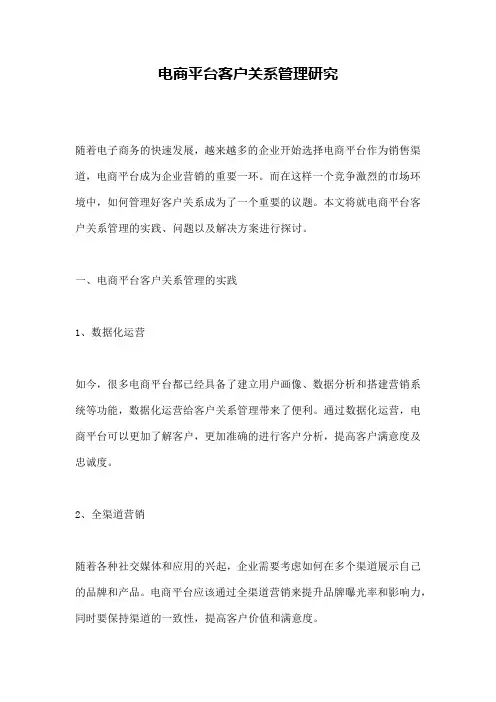
电商平台客户关系管理研究随着电子商务的快速发展,越来越多的企业开始选择电商平台作为销售渠道,电商平台成为企业营销的重要一环。
而在这样一个竞争激烈的市场环境中,如何管理好客户关系成为了一个重要的议题。
本文将就电商平台客户关系管理的实践、问题以及解决方案进行探讨。
一、电商平台客户关系管理的实践1、数据化运营如今,很多电商平台都已经具备了建立用户画像、数据分析和搭建营销系统等功能,数据化运营给客户关系管理带来了便利。
通过数据化运营,电商平台可以更加了解客户,更加准确的进行客户分析,提高客户满意度及忠诚度。
2、全渠道营销随着各种社交媒体和应用的兴起,企业需要考虑如何在多个渠道展示自己的品牌和产品。
电商平台应该通过全渠道营销来提升品牌曝光率和影响力,同时要保持渠道的一致性,提高客户价值和满意度。
3、关怀式服务关怀式服务是客户关系管理的重要手段之一。
通过专业的客户服务,可以获得客户的信任,吸引潜在客户的关注,并提高客户对品牌或产品的忠诚度。
电商平台可以通过客户服务平台、社交媒体、客户管理系统等多种渠道,提供24小时的售后服务,让客户感受到品牌的关怀。
二、电商平台客户关系管理的问题1、客户粘性不足在消费者应接不暇的市场环境下,企业要在众多竞争者中吸引并留住客户是一项不容易的任务。
当前,电商平台上的产品和服务普遍同质化,客户粘性不足,让客户转而选择竞争对手。
2、数据安全问题随着技术的发展,企业在客户关系管理中经常需要处理大量的客户信息、交易数据和用户行为数据。
但同时,数据泄密、信息丢失的风险也在不断增加。
因此,保护客户数据安全已经成为企业不可忽视的问题。
3、客户满意度不高目前,电商平台上的商品质量、物流服务和售后服务等方面仍然存在改进的空间,客户满意度不高,客户转化率也不高。
因此,如何提升客户满意度已经成为电商平台客户关系管理的一个重要问题。
三、电商平台客户关系管理的解决方案1、打造个性化服务通过数据分析,电商平台可以了解客户的需求和消费习惯,打造个性化的服务和推荐系统。
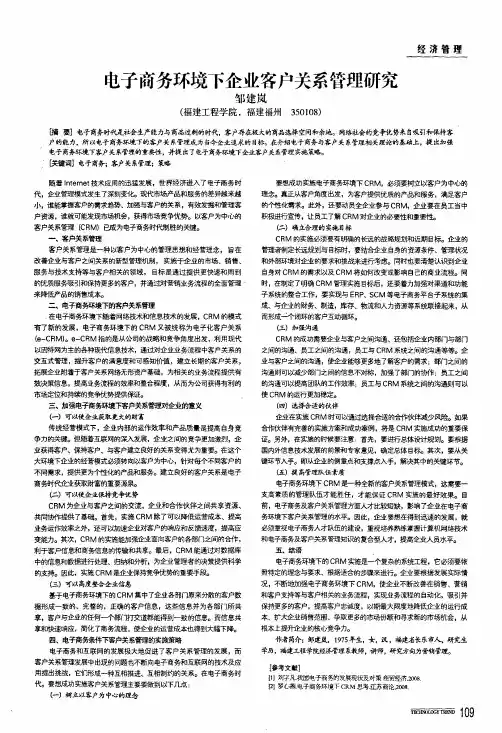
电子商务环境下企业客户关系管理研究邹建岚(福建工程学院,福建福州350108)经济管理[摘要】电子商务时代是社会生产能力与商品过剩的时代,客户存在极大的商品选择空间和余地。
网络社会的竞争优势来自吸引和保持客户的能力,所以电子商务环境下的客户关系管理成为当今企业追求的目标。
在介绍电子商务与客户关系管理相关理论的基础上,提出加强电子商务环境下客户关系管理的重要j生,并提出了电子商务环境下企业客户关系管理实施策略.o巨;键词]电子商务:客户关系管理;策略随着Int er ne t技术应用的迅猛发展,世界经济进入了电子商务时代,企业管理模式发生了深刻变化。
现代市场产品和服务的差异越来越小,谁能掌握客户的需求趋势、加强与客户的关系,有效发掘和管理客户资源,谁就可能发现市场机会,获得市场竞争优势。
以客户为中心的客户关系管理(CR M)已成为电子商务时代制胜的关键。
一、客户关系管理客户关系管理是一种以客户为中心的管理思想和经营理念,旨在改善企业与客户之间关系的新型管理机制,实施于企业的市场、销售、服务与技术支持等与客户相关的领域,目标是通过提供更快速和周到的优质服务吸引和保持更多的客户,并通过对营销业务流程的全面管理来降低产品的销售成本。
二、电子商务环境下的客户关系管理在电子商务环境下随着网络技术和信息技术的发展,C RM的模式有了新的发展,电子商务环境下的C R M又被统称为电子化客户关系(e—CR M)。
e—CR M指的是从公司的战略和竞争角度出发,利用现代以因特网为主的各种珊代信息技术,通过对企!必k务流程中客户关系的交互式管理,提升客户的满意度和可感知价值,建立长期的客户关系,拓展企业附着于客户关系网络无形资产基础,为相关的业务流程提供有效决策信息,提高业务流程的效率和整合程度,从而为公司获得有利的市场定位和持续的竞争优势提供保证。
三、加强电子商务环境下客户关系管理对企业的意义(一)可以使企业获取更大的财富传统经营模式下,企业内部的运作效率和产品质量是提高自身竞争力的关键。
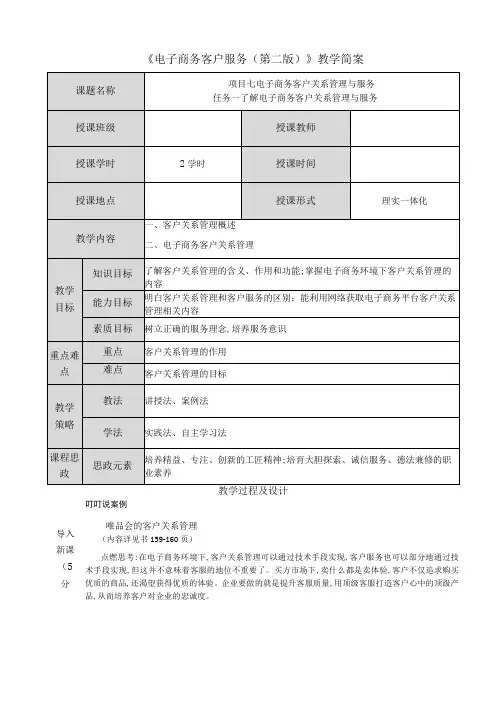
《电子商务客户服务(第二版)》教学简案叮叮说案例唯品会的客户关系管理 (内容详见书159-160页) 点燃思考:在电子商务环境下,客户关系管理可以通过技术手段实现,客户服务也可以部分地通过技术手段实现,但这并不意味着客服的地位不重要了。
买方市场下,卖什么都是卖体验,客户不仅追求购买优质的商品,还渴望获得优质的体验。
企业要做的就是提升客服质量,用顶级客服打造客户心中的顶级产品,从而培养客户对企业的忠诚度。
导入新课 (5 分被对手模仿。
建立客户关系管理系统,对手不易模仿,客户的资料都掌握在自己手中,其他企业想挖走客户则需要更长的时间、更多的优惠条件和更高的成本。
二、电子商务客户关系管理1.电子商务客户关系管理的主要内容电子商务客户关系管理的主要内容包括以下五个方面(D客户信息管理。
客户信息是企业决策的基础,是企业与客户进行有效沟通并对其进行分级管理的前提。
企业进行客户关系管理的第一步就是对服务对象(包括个人客户和企业客户)的基本资料、购买产品或服务记录等一系列相关信息进行收集和管理。
(2)客户满意管理。
客户满意是指客户使用前的预期与使用后所感知的效果相比较的结果。
对电子商务企业来说,客户满意有助于降低企业成本,提升企业的利润率。
(3)客户忠诚管理。
客户忠诚是从客户满意概念中引出的,是指客户满意后而产生的对某些产品、品牌或企业的信赖和维护,以及希望重复购买的一种心理倾向。
客户忠诚是客户对企业产品和服务的信赖与认可,坚持长期购买和使用该企业产品所表现出的在思想和情感上的一种高度信任和忠诚的程度,是客户对企业产品在长期竞争中表现出的优势的综合评价。
客户忠诚度越高越有利于企业经济效益的提高,同时也有助于改善员工的工作条件,提高员工的满意度和忠诚度。
(4)客户服务管理。
客户服务是企业通过营销渠道,为满足客户的需求所提供的包括售前、售中、售后等的一系列服务,是电子商务企业与客户沟通的主要桥梁,是企业客户管理的重要一环,目的是满足客户的服务需求。

浅谈电子商务客户管理一、电子商务客户管理的特点电子商务的兴起使客户管理的环境和形式都发生了变化,电子商务环境下的客户关系管理是依托互联网,以信息技术为手段,开展的一种新的理念与模式,与传统客户管理相比,有以下几个主要特点。
1.沟通的效率更高。
依托互联网的沟通方式具有及时性的特点,客户随时随地都可以准确地访问到企业的信息,了解企业的产品和服务,如果客户在了解企业产品与服务的时候产生了疑问,随时都可以进行在线咨询,并且会很快得到企业客服的回答。
这种互联网的及时沟通大大提高了沟通的效率,改善了沟通的效果。
2.成本更低。
互联网环境下,信息量庞大,任何组织和个人都可以以低廉的费用获得自己所需的信息,并且企业与客户通过充分沟通可以对双方的价值追求和利益充分了解并寻求最佳的合作方式。
同时,企业在与客户充分沟通和互动过程中能够更准确地掌握客户的需求并提供有针对性的产品和服务,这在一定程度上更有利于留住老客户,获得新客户,从而降低开发新客户的成本。
3.信息的高度集成。
电子商务模式使得客户管理中原本分散在各部门或各人那里的客户信息集成在一起,形成一个企业共享的信息库,客户使用电话、传真、E-mail、web等任何方式进行咨询,都会得到统一的满意的答复。
二、电子商务客户管理的作用1.提高业务运作效率。
电子商务环境下,企业内部信息实现了共享,业务流程得到了简化,员工处理业务的时间也相应地缩短,企业能够以最快的速度为客户提供服务,这在一定程度上缩短了业务运作的时间,提高了业务运作的效率。
2.保留客户,提高客户忠诚度。
目前市场上,同质产品越来越多,客户的选择也越来越多,而要赢得客户的青睐,留住客户,就需要深入的了解客户的真正需求,提供针对性的产品和服务。
而电子商务环境下,企业可以通过多种方式与客户进行充分的沟通与互动,收集客户的信息,通过对信息进行分析,挖掘客户真正的需求,然后根据客户的个性化需求进行产品的设计和定制。
客户的需求得到充分的满足,并得到贴心的服务,同时企业又为客户提供相应的优惠措施,这在一定程度上有利于留住老客户,提高客户的忠诚度。
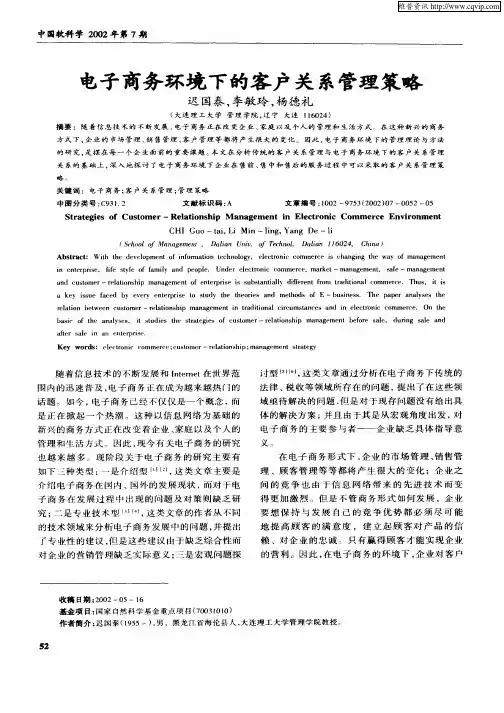
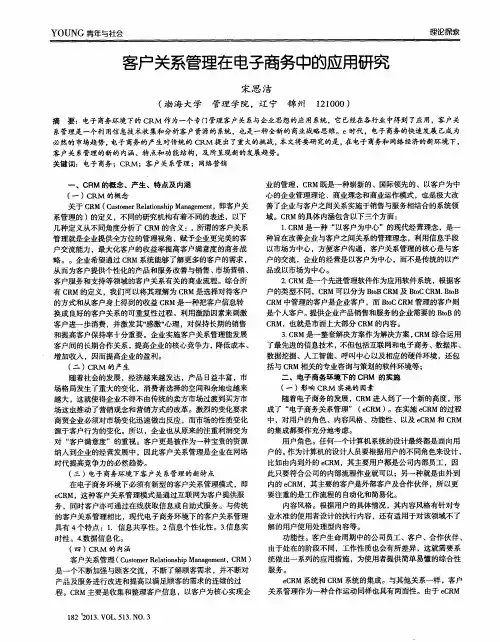
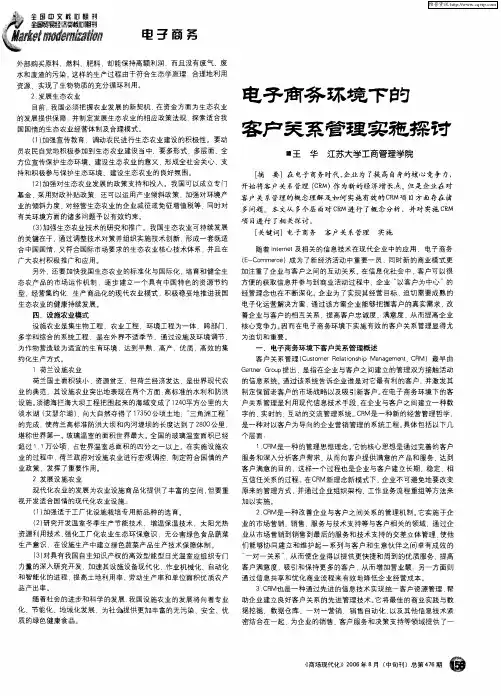
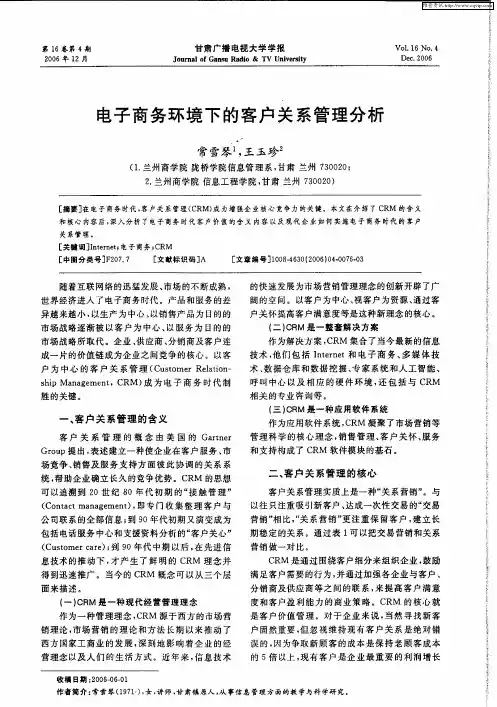
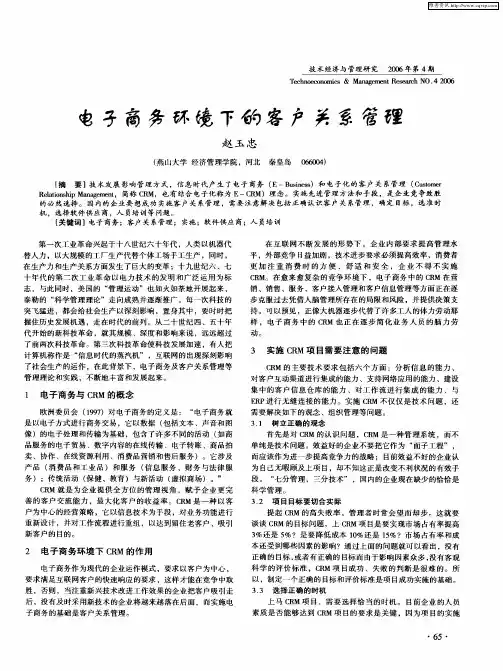
B2B电子商务平台的客户关系管理研究企业在进行B2B电子商务活动时,客户关系管理(CRM)是一项至关重要的策略。
以B2B电子商务平台为基础,有效的客户关系管理可以帮助企业与客户建立长期的合作关系,实现客户满意度的提升,以及销售业绩的增长。
本文将从客户关系管理的定义、重要性、方法和挑战等方面进行探讨,并为企业提供一些建议,以优化其B2B电子商务平台的客户关系管理。
首先,客户关系管理是指企业与其客户之间建立、维持和增强的关系。
这种关系不仅仅包括销售和交易,还涉及到对客户需求的了解、对其投诉和反馈的处理、产品和服务的改进等。
通过客户关系管理,企业能更好地理解客户的需求,提供个性化的解决方案,从而提高客户的满意度和忠诚度。
其次,对于B2B电子商务平台而言,客户关系管理具有重要的意义。
随着互联网技术的发展,企业与客户之间的交流和销售活动已经从传统的线下方式转移到了在线平台上。
B2B电子商务平台作为企业与客户之间的桥梁,通过提供商品信息、交易功能和客户服务等,可以更好地满足客户的需求,提高交易效率和准确性。
然而,在实施B2B电子商务平台的客户关系管理过程中,企业可能会面临一些挑战。
首先是海量的客户数据处理和分析工作。
B2B电子商务平台产生的数据庞大且复杂,如果企业不能及时有效地利用这些数据,就会影响客户关系的建立和维护。
其次是与客户之间的有效沟通。
在线平台的交流方式相对有限,企业需要通过电子邮件、在线聊天、电话等渠道与客户保持沟通,以便更好地了解客户的需求并提供解决方案。
另外,全球化的竞争环境也给客户关系管理带来了挑战。
企业需要面对来自世界各地的竞争对手,灵活的客户关系管理策略可以帮助企业在竞争中脱颖而出。
为了成功实现B2B电子商务平台的客户关系管理,企业可以采取以下方法和策略。
首先,建立一套完善的客户数据库。
企业应该收集和整理客户的基本信息、交易记录和反馈意见等,以便更好地了解客户需求并制定个性化的服务方案。
电子商务信息环境下的网络化客户关系管理与客户价值关系研究摘要:本文主要阐述了在电子商务模式下,客户关系管理的应用系统在整个电子商务应用的基础架构中的地位及作用,以及网络方式下进行客户关系管理的优势。
同时,通过进一步阐述客户价值的重要性,说明了在电子商务的背景下,只有充分地将客户关系管理与客户的终生价值整合起来,才能实现企业的长期利润。
abstract: this article mainly elaborated the position and role of application system of customer relationship management in the infrastructure of electronic commerce application in the e-commerce model, as well as the advantages of carrying out customer relationship management under the network environment. at the same time, through further elaboration on the importance of customer value,illustrated only by integrating customer relationship management and customer lifetime value fully in the context of e-commerce, can enterprises’ long-term profits of be achieved.关键词:客户关系;e客户;客户价值;网络环境;电子商务key words: customer relationship;e customer;customer value;network environment;electronic commerce 中图分类号:tp39文献标识码:a 文章编号:1006-4311(2012)31-0188-02网上客户关系管理(e-crm)主要是建立在因特网网站的客户关系管理系统之上的。
毕业论文(设计)外文翻译标题:Dynamic Customer-Relationship Management Model in Electronic Commerce Environment原文:Abstract: With the development of information technology, Electronic Commerce is changing the way of management in enterprise, lifestyle of family and people. Under Electronic Commerce, market-management, sale-management and customer-relationship of enterprise are substantially different from those of traditional commerce. This has created a significant challenge to enterprise management. The marketing strategies of Electronic Commerce (e-commerce)have really changed. The Customer-Relationship Management Model established under e-commerce can help enterprises to reduce costs, enhance partners’ cooperation, attain the desired customer value, and promote enterprise competition. Therefore, we regard Relationship Management as the greatest change that requires a fresh approach through a new model. The paper analyzes the relation between customer-relationship management in traditional circumstances and that in e-commerce environment, and expatiates on characteristic of customer-relationship management under e-commerce. On the basis of the analyses, the paper studies the model of Dynamic Customer-Relationship Management before sale, during sale and after sale in the enterprise.Keywords: Dynamic customer-relationship management; enterprise competition; E-commerce; model; business-to-customer.1 IntroductionCustomer Relationship Management (CRM) has become a focus of marketing academic circles and corporation community. Around the world, research on CRM originated from “Contact Management” in the earlier 1980s. Until the earlier 1990s, researchers have become aware of “Customer Care” based on the telephone service center and supporting material analysis. Afterwards, researchers have focused on customer-maintaining whose purpose is to manage Customer Relationship effectively.With standardizing of application of CRM in the domestic enterprises, domestic researchers have come to focus on CRM, some higher level research achievements have emerged continuously, but these research achievements are related to customer relationship based on Business-to-Business (B2B) which centers on identifying of enterprise-customer and its maintaining, not focuses on the customer relationship based on Business-to-Customer (B2B) which is the relationship between business and other customers, for example, employees, shareholders, ultimate customers, other cooperation partners, especially ultimate customers. One-to-one marketing based on the mode of B2B has presented a good application prospect in a walk of life. For example, “common customer flight plan” in aviation industry and “golden card project plan” in a health club are all tactics of customer relationship management made in the light of ultimate customers, whose purpose is to maintain stable long-term relation with the customers to attain “bilateral win” or “multilateral win”. As to research methods, most of research achievements on CRM are quantitative and static, less pointing out clearly how to make marketing decision and how to implement customer relationship strategy. The reason is that the profit resulted from these research achievements is insufficient for making up for the huge cost of collecting and conserving database. There is lack of the research on customer-relationship management based on quantitative and static conditions under theMode of B2C. Customer Relationship Management can’t work without all kind of knowledge about employees, customers and cooperative partner. Therefore, it is very important to research dynamic customer-relationship management based on knowledge management under the mode of B2C. On the basis of analyzing characteristic of trading between enterprise and ultimate customers under the mode of B2C, the paper addresses the mode of dynamic customer-relationship management based on knowledge management, and points out the guiding meaning about the enterprise CRM practice and the future research direction.2 General Issues and Concepts.Relationship Marketing and Customer-relationship Management Most relationship marketing definitions stress the need to develop long-termrelationships with customers and sometimes other stakeholders (Galantines, 1994; Gringos, 2000). Jackson published an insightful book and an article on business-to-business marketing (B2B) in 1985 (Jackson, 1985) where she defined relationship marketing by contrasting it with transaction marketing. From her comprehensive study she drew a general conclusion that building long-term relationships through relationship marketing should sometimes be the preferred strategy for the industrial seller, but sometimes transaction marketing, the one-shot deal with a short-term perspective should be preferred. She argued that it all depends on the situation. Et al. (1997) identified four types of marketing in their research. One is transaction marketing, but the others have a relational content: database marketing (information exchange with the help of IT); interaction marketing (face-to-face or ear-to-ear interaction); and network marketing, as essentially (but not solely) a B2B phenomenon where networks of relationships are built with a large number of stakeholders.CRM is the values and strategies of relationship marketing - with particular emphasis on customer relationships - turning into practical application. The implementation steps used in one-to-one marketing summarize well what is needed to practice relationship marketing: identify individual customers and establish how to reach them; differentiate the customers with regard to values and needs; interact with the customers efficiently and effectively; customize your offerings; and, finally, in the process of doing this, build learning relationships with your customers through dialogue (Peppers and Rogers, 1999; First, 2000; Newell, 2000).3 Characteristics of Customer Relationship Management under Electronic Commerce3.1 Similarity between Electronic Commerce and Traditional Business3.1.1 Identified PurposeDespite customer relationship management under electronic commerce is superior to that in traditional business, the identified purpose of electronic commerce and traditional business is how to satisfy customers' demand and desire, just customer relationship management under electronic commerce is easy to realize the purposewith the help of network information technology.3.1.2 Identical effectThe purpose of implementing customer relationship management is to grasp and satisfy certain customers demand and desire, establish service concept which is centering on customers, and make enterprise establish an unassailable position in severe market competition.3.2 Characteristics of Customer Relationship Management under Electronic Commerce3.2.1 AdaptabilityIn comparison with customer relationship management under traditional business circumstances, customer-relationship management in electronic commerce has mighty advantage about its adaptability, which includes two aspects, i.e., time adaptability and space adaptability. Having made full use of network information technology, enterprise should realize the service mode of 365×24; time and space would impede trading among regions in the world no longer. Much trading has being proceeded among regions, enterprises, and countries at any time. Because the emerging business manner is very convenient for customers, the degree of satisfaction of customers will be improved with the development of commerce manner.3.2.2 AutomaticityCompared to customer-relationship management under traditional business environment, customer-relationship management in electronic commerce could make full use of advanced information technology. Supported under network information technology, enterprise could realize paperless customer-relationship management authentically. In traditional customer-relationship management, we frequently request customers to fill in questionnaires about a base data sheet and commodity quality feedback, but the firsthand information-papered materials need to be put in order, copied with, and analyzed by man-manner, this results in mistakes and low efficiency. In electronic commerce environment, all statistic data are input into a database directly, technology is shared, statistic data are exchanged, with the computer calculating and handling ability, we are very easy to deal with and analyze thesestatistic data.3.2.3 Interaction characteristicCustomer-relationship management in electronic commerce environment could carry out real time and two-way dialogue communication mode. Because internet has possessed quite interaction characteristic and guidance, under system guidance, customers often chose their production and service and put up their request through the internet, enterprises come to produce and provide service timely according to customer's choice and request. All these could realize real time and two-way dialogue with customers. Enterprise will provide more content services for customers.4 DCRM under the Mode of the B2C4.1 Characteristic of Trading Between Corporation and ConsumerTrading process between corporation and customer is considered as continuous interactive process. In the every period, enterprise decides to adopt certain marketing constituting tactics, for example price and communication tactics, customers decide if he or she will participate in the enterprise marketing constituting tactic in the light of customer purchasing commodities. So, thetrading process between enterprise and customers has become stochastic game process. The consumer's decision influences the enterprise marketing, and illustrates transformation from one state to another state. From a view of corporation, customer's decision is ransom variable, under the hypothesis which purchasing decision is only a function of customer and corporation tactic, customers state sequence has formed the Markov chains. Because enterprise have ability to control the evolution of the Markov chains by choice controlling variable, customer relationship management under the mode of B2C is considered as Markov decision process.4.2 DCRM Implication under the Mode of the B2CThe“Dynamic”in Dynamic Customer-Relationship Management includes three layer significance, i.e., first, from marketing management, dynamic customer-relationship management system should focus on the marketing tactic influence on customer net asset value. This could heighten expecting returns, reduce marketing cost; secondly, from quantitative analysis, dynamic customer-relationshipmanagement system should care about not only present benefits and also future benefits when enterprise makes a decision. Thirdly, dynamic customer-relationship management system should follow with interest in customer and enterprise benefits, not one side benefits. So, dynamic customer relationship management under the mode of B2C is a method which is how to analyze customer behavior quantitatively on the basis of “multilateral win”.5 DCRM Model in Electronic Commerce Environment5.1 DCRM before Sale5.1.1 Establish customer's filesThe purpose of establishing customer's files is to grasp customer's specific characteristic information including sex, age, profession and interest to understand customer consuming tendency. In electronic commerce environment, enterprise could make full use of establishingCustomer files through sharing network statistic database resources. Under network environment, customer input his essential datum in database, which will be reserved in enterprise all the time. Every section of enterprise shares the resources.5.1.2 Renew customer's filesRenewing customer's files means renewing customer's specific characteristic information in time in the light of time and variation after enterprise establishes files for customers. The computer system can renew basic data of natural change automatically. For example, the data that is about customer age, while entering a new annual, customer age will automatically add one year of customer relationship management in electronic commerce environment; if using all manners of communication in basic data, it is unable to keep track of the customer, this record will become invalid and computer system will automatically delete this record.5.2 DCRM during Sale5.2.1 Participate in serviceParticipating in service indicates that customer take part in product designing in order to acquire Individuality product which satisfies customers. Under electronic commerce, people have their individuality about demand for productions. productmarket is named as face-to-face market. Based on providing product common model by corporation, customer puts up his or her requests. Corporation produces products in the light of customers' demand; this could enhance customer's degree of satisfaction and save designing cost. For example, Dell sells personal computer under the model of B-to-C, customer could pick out personal computer on the enterprise website, and producing department organizes product production according to customer request. Dell sales volume of 1996 is 71% more than that of 1995 by using the model of the B-to-C.5.2.2 Infer other Demand of CustomerInferring other demand of customer indicates that enterprise could speculate other demand of customer by analyzing customer purchasing behavior to improve the sale volume of product and heighten customer content. For example, when a twenty-six years old woman buys a baby bottle, we are easy to think of that the woman has a lovely baby; we can infer that the woman could buy baby food, baby costume, baby toy and so on. When the customer touches a sort of baby bottle, system will show automatically all sorts of baby commodities. If a customer buys one portable computer, we can infer that this customer belongs to high-grade customers, and speculate that superior quality products such as digital camera and family cinema belong to a scope of customer's purchasing. So when customer touches on the portable computer, system will show automatically digital camera and family cinema and so on. The manner of “Inferring” could advertise for enterprise product.5.3 DCRM after Sale5.3.1 Track ServiceTracking service indicates that the enterprise provides service for all customers after sale at any Time. Under electronic commerce, the enterprise should provide lifelong service for customer after sale through establishing customer files and utilizing the advantage of network. The high quality service will forever be a good way of creating and maintaining customer. In the keen competition of market, service for customer is no longer a sort of passive reaction when customer puts up a certain request, the enterprise should regard customer as “God”.5.3.2 Customer self-serviceCustomer self-service indicates that enterprise excavates customers latent and improves service quality by interacting with customers. There exists a common phenomenon in our real life, if product has many kinds of functions; customers only know one or several kinds of common functions. This brings about wasting product function and weakening product competition. Under electronic commerce, customer self-service can solve this problem.5.3.3 Emotions communicationEstablishing good relationship with customer is the key to customer-relationship management in electronic commerce and traditional business environment. Under electronic commerce, customer frequently carries out his or her business in the internet; the enterprise is very difficult to get in touch with customer, so it has become more important for the enterprise to actively communicate with customer. Under electronic commerce, the enterprise should make full use of network information technology. E-commerce system sends automatically a greeting card to customer on his or her birthday and wedding anniversaries and so on to express enterprise's congratulation to customer. In the meanwhile, the enterprise may recommend enterprise new product to customer. Like this, customer will not forget the enterprise website and browse enterprise web more5.4 DCRM Model in Electronic Commerce EnvironmentWith above theory framework, we may construct the DCRM model in electronic commerce environment as follows:6 ConclusionsCustomer relationship management in electronic commerce environment which is very different from that in traditional business circumstances puts emphasis on one-to-one relationship marketing; it is dynamic customer relationship management. Before sale, company should establish and renews customers files, design friendly interface, differentiate market and induce new consuming of old customer. During sale, company should make customers taking part in product designing in order to acquire individuality product which satisfy customer, Infer other demand of customerand analyze customer purchasing behavior in order to improve the sale volume of product and heighten customer content. After sale, company should track customer, establish self-service platform to let them communicate with each other and enterprise in order to acquire more product information and communicate with customers. Customer relationship management in electronic commerce environment must encircle the center of customer, satisfy customer with demand and provide lifelong service for customers. Like this, the enterprise improves the quality of product and service, increase sales volume, enhance the degree of customer loyal and promote the enterprise competitiveness.出处:Wang Xuejun Rao Yangde,Business School, Wuhan University,Wuhan 430072 China,ICEMI’2005二、翻译文章标题:在电子商务环境下的动态客户关系管理策略译文:摘要:随着信息技术的发展,电子商务在改变企业管理策略的方向,家庭和人们的生活方式,在电子商务中,市场策略营销策略和企业的客户关系和那些传统的商务有大量的不同。
人工智能在电子商务中的智能客户关系管理随着信息技术的快速发展和智能化的进步,电子商务已经成为当今商业领域最重要的一环。
为了满足日益增长的客户需求并提供个性化的服务,人工智能(Artificial Intelligence, AI)正在被广泛应用于电子商务中的客户关系管理(Customer Relationship Management, CRM)领域。
本文将探讨人工智能在电子商务中的智能客户关系管理的应用和发展趋势,旨在引起人们对这一领域的关注和思考。
一、人工智能作为一种模拟人类智能的技术,可以帮助电子商务企业更好地理解和满足客户需求,从而提高客户满意度和忠诚度。
在电子商务中,智能客户关系管理的关键在于收集、分析和利用大量的客户数据。
人工智能可以通过机器学习和数据分析技术,对客户数据进行深度挖掘,并生成有价值的洞察,从而提供个性化的服务和推荐。
1.1 个性化推荐系统个性化推荐系统是电子商务中智能客户关系管理的一个重要组成部分。
通过分析客户的历史购买记录、浏览行为和兴趣爱好等信息,人工智能可以预测客户的需求,并向其推荐相关的产品或服务。
个性化推荐系统不仅可以提高客户的购买转化率,还可以增强客户对品牌的信任和忠诚度。
1.2 智能客服机器人智能客服机器人是人工智能在客户关系管理中的另一个应用。
通过自然语言处理和机器学习技术,智能客服机器人可以理解客户的问题并提供准确的解答或帮助。
智能客服机器人可以根据客户的需求和特点,提供个性化的服务并解决问题,从而提高客户满意度和忠诚度。
二、人工智能在电子商务智能客户关系管理中的发展趋势2.1 情感分析和情绪识别情感分析和情绪识别是人工智能在电子商务智能客户关系管理中的新研究方向。
通过分析客户在交互过程中的语言和语调等信息,人工智能可以感知客户的情感和情绪状态,并根据其需求进行个性化的服务和销售推荐。
情感分析和情绪识别可以帮助企业更好地理解客户的情感需求,并采取相应的应对策略。
客户关系管理客户关系管理(Customer Relationship Management,简称CRM)是指企业通过建立有效的客户沟通和关系维护机制,以实现与客户的长期互利合作关系。
在当今竞争激烈的市场环境下,客户关系管理对企业的成功至关重要。
本文将从以下几个方面对客户关系管理进行论述。
一、客户关系管理的定义与重要性客户关系管理是一种综合性的管理理念和策略,它将客户作为企业最宝贵的资源进行管理和维护。
客户关系管理的核心是通过建立和维护良好的客户关系,提高客户满意度,从而保持客户忠诚度,增加客户存量和价值。
客户关系管理不仅仅是一种市场营销手段,更是企业长期发展的关键。
客户关系管理的重要性体现在以下几个方面:1. 增强客户忠诚度:通过有效的沟通和关系维护,建立与客户的互信关系,提高客户的忠诚度,减少客户的流失率。
2. 提升客户满意度:通过了解客户需求,及时解决客户问题,提供个性化的产品和服务,提高客户满意度。
3. 拓展客户生命周期价值:通过客户关系管理,不仅可以增加客户的购买频率和购买金额,还可以推荐新的产品和服务,实现客户的交叉销售和升级消费。
4. 提高市场竞争力:建立良好的客户关系和口碑传播机制,能有效提高企业的品牌知名度和市场竞争力。
二、客户关系管理的主要策略为了有效实施客户关系管理,企业需要制定相应的策略和措施。
下面介绍几种常见的客户关系管理策略:1. 个性化营销策略:通过挖掘和分析大数据,了解客户的需求和偏好,为客户提供个性化的产品和服务,提高客户满意度和忠诚度。
2. 建立客户数据库:建立完善的客户数据库,包括客户基本信息、购买记录、投诉建议等,以便企业进行精准的客户分类和管理。
3. 提供全方位的客户服务:企业需要建立完善的客户服务体系,包括售前咨询、售中培训、售后服务等环节,确保客户得到及时、高效的支持。
4. 主动沟通和反馈机制:及时了解客户对产品和服务的评价和建议,主动与客户沟通,解决问题,改进服务质量。
电子商务环境下的客户关系管理 2
电子商务环境下的客户关系管理 摘要: 随着市场经济的深入和信息技术的发展,客户关系管理已成为现代营销领域所关注的一个新热点。越来越多的企业意识到客户是利润的源泉,它们希望通过对客户这项资源的管理,与客户之间保持一种亲密的、伙伴式的关系。Customer Relationship Management(CRM)既是一种管理理念又是一个软件系统。在信息爆炸的时代,信息对于企业以及个人都有着非常重要的意义。通常,掌握信息的多少是成功的关键。针对企业信息化,信息更重要。但也面临着如何组织,管理和分析信息的问题。而此时,对客户的资料的管理的理念和技术正孕育而生了。本文通过对客户关系关系管理相关知识理论进行分析,以及企业在电子商务环境下,如何进行客户关系管理的问题,并以此为基础提出相应的建议和对策。 关键词:电子商务;客户关系管理 ;建议和对策
一、引言 客户是企业的一项重要资源,它具有资源的可管理性特征。随着市场经济的不断深入,产品和服务越趋于同质化,在这样的背景下,企业想要占领市场,凸显竞争优势,都得在客户这里做文章。随着信息化技术的发展,借助网络和软件,使企业和客户之间“一对一”的双向沟通成为了可能。客户关系管理已成为现代营销领域所关注的一个新热点,西方学者在这方面已经做了很多研究,但在中国,对客户关系管理的研究起步尚晚,在具体运用方面仍无共识。本文将从不同的角度来阐释客户关系管理的内涵和作用,并提出了几点具体的实施方案,力求为企业在实际运用中提供一定的理论基础。
二、客户关系管理概念 关于CRM的定义,不同的研究机构有着不同的表述。 最早提出该概念的Gartner Group认为:所谓的客户关系管理就是为企业提供全方位的管理视角;赋予企业更完善的客户交流能力,最大化客户的收益率。Hurwitz Group 认为:CRM的焦点是自动化并改善与销售、市场营销、客户服务和支持等领域的客户关系有关的商业流程。关于客户关系管理的定义,目前普通被接受的是Gartner Group 和IBM 所给出的。Gartner Group 最先提出了客户关系管理的概念:“客户关系管理是一种以客户为中心的经营战略,企业通过对客户的细分来组织实施企业资源,以客户为出发点设置经营模式、业务流程,并通过这种手段来提高企业的利润,提升客户满意度”。IBM 认为客户管理有两个层面,首先,通过各种技术手段了解客户及潜在客户的需求,然后,通过对客户信息的整合,预测客户想要获得的产品或服务,再通过各个相关部门进行一对一的个性化服务。综上所述,客户关系管理是一种以客户为核心的商业策略,它借助了信息技术和互联网,以客户为导向实施营销、销售、服务等一系列工作,力求与客户之间建立持续性的关系,从而达到吸引新客户、留住老客户、提高客户忠诚度和客户利润贡献度的目的。 3
三、实施客户关系管理给企业带来的优势 客户关系管理首先是一种管理理念,早先的研究是从心理学、组织行为学开始的。它要求企业一切从客户需求出发,将客户为中心的思想融入到企业文化中,通过对客户信息的管理,来为客户提供满意的产品或服务,实施客户管理主要有以下几点作用。 1、了解客户个性化需求 在商品经济发达的今日,市场上同质产品越来越多,消费者日趋成熟,传统的企业管理专注于产品的研发、设计和制造,而对于与客户的互动未有过多的涉及,这种“闭门造车”的方式已陈旧而不可取了。在这种情境之下,只有通过客户关系管理的方式,深入了解客户真正所需,根据客户需求来设计、定制产品,提供令消费者“惊喜”的服务,才能赢得客户,留住客户。 2、提供针对性服务,与客户实现良性互动 意大利经济和社会学家帕雷托“二八法则”表明:企业80%的利润来自于20%的优质客户,这就表明了这些优质客户对企业的重要性。客户关系管理可以通过对客户信息的收集、分析,找出这些优质客户,并提供有针对性的服务。通过客户定制,为客户创造更加贴心的服务。客户关系管理的模式能让“一对一”的服务形式成为可能,真正实现与客户的即时互动,体现客户为中心的经营理念。每一个企业都有一定数量的客户群,企业只有对客户的需求进行深层次研究,才有可能带来更多的商业机会。在实施客户关系管理过程中,系统会产生大量有用的客户数据,利用智能的分析工具即可发现很多客户的潜在需求,实现针对性营销策略。 3、提高客户忠诚度,挖掘客户潜在价值 对于很多企业来说,最大的成本之一就是吸引新客户,一般吸引一个新客户的成本比保留一个老客户要高出4-6 倍。因此,留住老客户,直至客户忠诚的建立,对于企业来讲意义重大。企业通过加强客户关系管理,可以了解他们情感、心理的诉求,帮助客户实现价值最大化。这样,客户会对企业的文化、价值产生认同感,也会形成一种心理依赖,当竞争者想要抢夺客户资源时,客户会考虑转换成本。客户关系管理的目的是发展从短期交易转变为开发客户终生价值。在电子商务环境下,企业可提供多种与客户进行交流和业务往来的方式,企业的客户数据库可以记录下每一位客户的信息。客户关系管理系统可帮助企业对客户的信息进行分析,整理出每一位客户的个性化需求。除此之外,企业还可以根据客户的不同交易记录,将客户按一定的标准进行分类,提供不同层次的优惠措施和售后服务,提高客户忠诚度,确保客户能与企业长期开展业务。 4、降低成本,实现利润最大化 客户关系管理以增进企业与客户之间关系为目标,以增强企业与客户的互动性为载体,通过科学管理,企业更准确地对客户群进行分类跟踪,大幅度提高了企业的营销和销售过程的自动化程度,有效降低了销售成本和营销费用。同时,客户关系管理通过数据挖掘技术对掌握的大量的客户信息进行分析,从中能发现潜在的客户需求,挖掘新的商机,实现交叉销售,增加了收入源。Bryan 的一项研究统计发现,客户流失率降低2%就相当于降低了10%的成本,客户忠诚度提高5%,可致企业利润增长25%-85%。实施客户关系管理,能与客户之间形成相互信任的合作伙伴式关系,这样可以大幅减少广告及其他营销费用的支 4
出。同时,良好的消费体验能产生口碑营销的效用,国外的研究数据表明,100 个满意的客户会带来24 个新客户。总之,采用客户关系管理,企业与客户的关系会更加密切,客户的转化率会进一步提高,客户的流失会明显减少,并从中能挖掘出新的商机,达到有效降低成本和增加收入的成效。 5、.提高业务运作效率,进一步拓展市场 由于信息技术的应用,企业内联网实现了企业内部范围内的信息共享,企业业务流程处理的自动化程度大大提高,大大缩短了业务处理的时间,简化了员工的工作。企业外联网与内联网的无缝对接使企业内外的各项业务得到有效的运转。保证客户能在最少的时间内以最快的速度得到满意的服务。所以,客户关系管理的有效实施可以帮助企业缩短产品生产、销售的周期,降低原材料和产品的库存,提高资金的运转率,提高业务运作效率,给企业带来更多的经济效益。客户关系管理系统对收集到的客户信息进行分析,能预测市场活动、销售活动的变化趋势,能从不同的角度提供影响产品、成本和利润数据的因素,并对客户分布、市场需求趋势的变化做出科学合理的预测,以帮助企业能更好地把握拓展市场机会。 四、电子商务环境下客户关系管理的新特点 电子商务环境下的客户关系管理是在传统商务环境下的客户关系管理的基础上, 以信息技术和网络技术为平台的一种新兴的客户管理理念与模式,。在传统环境下,由于企业内部各部门业务运作的独立性,客户信息的收集比较分散,信息共享度低,因此客户关系管理的成效不明显。电子商务环境下的客户关系管理,有效地实现了客户信息收集、分析、开发和利用的整合,它具有以下新特点: 1.信息的共享性 客户关系管理系统将企业内部原来分散的各种客户信息进行了格式的规范处理,形成了正确、完整、统一的客户信息为各部门所共享,确保了客户与企业任一个部门打交道都能得到一致的信息。 2.服务的针对性 客户与企业交往的各种信息都存贮在企业的数据库中,利用客户关系管理系统的数据分析功能,准确判断客户的需求特性,最大限度地满足客户个性化的需求,有的放矢地开展客户服务,最终以提高客户的满意度与忠诚度。 3.交流方式的多样性 客户既可选择电子邮件、电话、传真等方式与企业联系,又可以选择QQ,MSDN等在线聊天工具与企业联系,还可通过企业网站专门设置的FAQ与企业联系。无论采取哪种方式,客户都能得到一致的答复,因为在企业内部的信息处理是高度集成的。
五、客户关系管理的实施方略 从以上分析可以发现,客户关系管理可以通过管理理念和信息技术手段,为企业构建良好的客户关系,改善客户消费体验,提高客户满意度、忠诚度,从而为企业创造更多利润,因此,企业实施客户关系管理有极其重要的现实意义。 1、企业上下转变观念,认识客户关系管理的重要性 要实施客户关系管理,领导首先要高度重视并给予支持,改变传统的管理观念。企业各部门之间要实现客户信息共享,全体员工要摒弃陈旧的经营模式, 5
树立“以客户为中心”的思想,加强信息化技术培训,使员工具备与客户建立相互认同感的能力。建议企业设立新的业务流程和组织架构,建立以客户满意度为衡量的员工考核和激励机制。 2、构建企业文化,健全客户管理体系 企业文化是一家企业长期发展形成的价值观、信念、原则、经营方式,是全体员工的思想作风和行为规范。客户关系管理是企业整体业务流程的体现,是企业与外界市场联系,与客户接触的“眼睛和耳朵”。这就需要企业以客户关系为重点打造自身的企业文化体系,形成全新的商业战略思维。同时,企业需探索一套健全的管理体系,这是成功实施客户关系管理的重要保障。 3、处理好技术和人的关系 CRM是一套信息处理系统,良好的IT 基础设施是CRM 正常运行的保障。企业需建立健全内外部网络,外部网络负责客户信息数据的采集,内部网络实现客户数据在各部门之间的共享。CRM系统不单单是一项技术,还是技术与管理之间的融合,因此,企业要培养一支熟练操作系统的员工队伍,确保在信息技术上能为客户关系的建立提供人力保障。 4、整合营销模式,提高客户忠诚度 企业需从客户关系管理的理念出发形成一套战略思维,并渗透到营销的各个环节,产品的设计、渠道开发、价格制定、促销策略都应体现想客户所想,为客户创造更高的价值。在这样的营销模式下,能与消费者、供应商、分销商、政府等公众发生良性互动,提供给客户比竞争者更具吸引力的产品或服务,从而提高客户的满意度和忠诚度。越来越多的企业意识到客户是利润的源泉,它们希望与客户之间保持一种亲密的、伙伴式的关系,打造一批属于的自己的忠诚客户群体。客户关系管理理论的出现让这一切变为了可能,随着信息科技技术的加入,又引领了新一轮的营销模式的转变。本文从人文管理和信息技术两方面对客户关系管理加以了阐释,CRM 既是一种管理理念又是一个软件系统。企业要谨记从客户出发开展各项活动,保持与客户的友好关系,为客户创造终身价值,从而提高客户忠诚度和企业利润率,实现企业与客户的双赢。 5、客户关系管理系统的实施要把远景规划和近期目标结合起来 管理者在制定远景规划和近期目标时,既要考虑企业内部的现状和技术条件及实际管理水平,也要看到外部 市场对企业的要求与挑战。只有明确了实施客户关系管理系统的目的,才能制定出适合企业自身的客户关系管理远景规划和近期实现目标。 6、通过业务来驱动客户关系管理项目的实施 客户关系管理系统是为了建立一套以客户为中心的销售服务体系,因此客户关系管理系统的实施应当是以业务过程来驱动的。IT技术只是为客户关系管理系统的实现提供了技术可能性,但客户关系管理真正的驱动力应来自于业务本身。要在软件提供的先进技术与企业目前的运作流程间找到平衡点,尽可能的在应用中保留企业流程的特点和优势。 (四)建立项目实施小组 项目组成员由企业内部成员和外部的实施伙伴共同组成。内部人员主要是企业高层领导、相关实施部门的业务骨干和IT技术人员。业务骨干要求他们真正熟悉企业目前的运作,并对流程具备一定的发言权和权威性。 7、有目的有步骤的实施业务调整 项目的实施会使业务流程发生变化,同时也会影响到人员岗位和职责的变化,甚至引起部分组织结构的调整。因此需要考虑对业务用户的各种培训,以